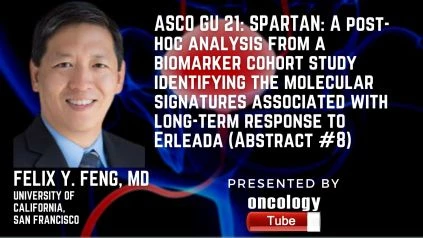Felix Y. Feng, MD, professor of radiation oncology, urology, and medicine from the University of California, San Francisco speaks about the ASCO GU 2021 abstract – SPARTAN: A post-hoc analysis from a biomarker cohort study identifying the molecular signatures associated with long-term response to Erleada (Abstract #8).
Link To Abstract –
https://meetinglibrary.asco.org/record/194572/abstract
Context:
A phase 3 placebo (PBO)-controlled study of SPARTAN in nmCRPC patients (pts) has shown that APA plus androgen deprivation therapy (ADT) substantially increases metastasis-free survival compared to PBO + ADT. Potential biological signatures of pts with long term responses to APA and PBO were examined in this exploratory study.
Methodology:
Based on time to metastasis, the SPARTAN biomarker cohort was characterized as long-term responders (LTR) or early progressors (EP), and divided into quartiles for the APA and PBO classes. Pts progressing in the first quartile (APA, 21; PBO, 17) were classified as EP with the shortest time to metastatic occurrence, while those progressing in the last quartile (APA, 39; PBO, 20) were classified as LTR. From 233 archival primary prostate tumors, gene expression profiles were created. A 2 sample t test was used to compare predefined gene signatures indicative of cancer biology between LTR and EP groups within the APA and PBO arms. LTR and EP-associated signatures have been established using p values of less than 0.05.
Outcomes:
The median time for metastatic progression was 40.5 months for APA pts and 22 months for LTR group PBO pts and 7.3 and 3.6 months for EP group APA and PBO pts, respectively. Increased T cell activity expressed by T cell activation (p = 0.0045), stimulation (p = 0.0642), cytokine response (p = 0.0489), and interferon production (gamma response p = 0.0227), and decreased T cell exclusion (p = 0.0652), low proliferative cell exclusion (p = 0.0652), cytokine response (p = 0.0489), and interferon production (gamma response p = 0.0227) were included in signatures categorized into 3 general mechanistic classes (immune regulation, proliferation, and hormone dependence) associated with LTR on APA. Early development of PBO therapy was associated with high risk (DECIPHER p = 0.0406, metastatic potential p = 0.0077), hormone nonresponsive (basal p = 0.0115; androgen receptor activity-low, p = 0.0437), and neuroendocrine-like tumors (p = 0.0125).
Findings:
Although in larger studies the data need confirmation, these molecular determinants may be useful in choosing pts with nmCRPC that may gain the most value from APA and other inhibitors of androgen signaling. Data from a clinical trial: NCT019462044

